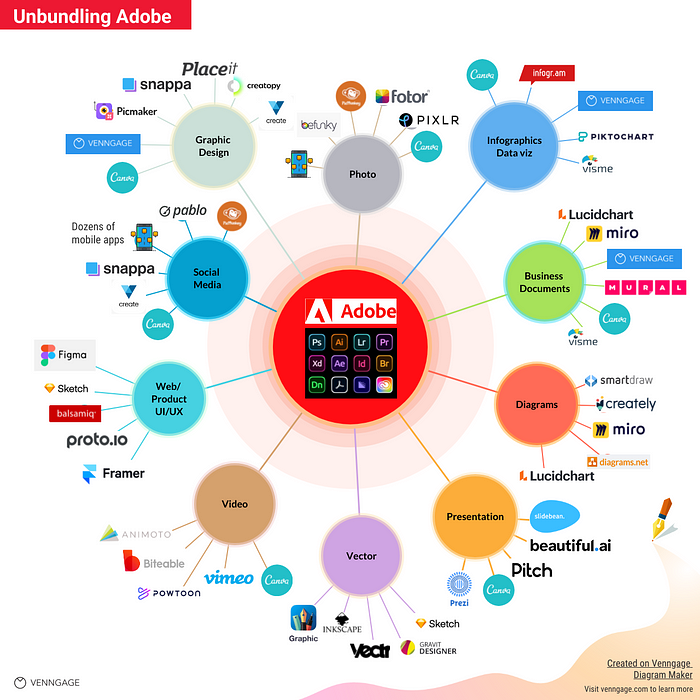Unbundling Adobe

10 years ago, the Adobe suite of design tools (Illustrator, Photoshop,etc.) was the only serious tool for most design use cases. Everything, from designing simple marketing flyers to more complex designs such as websites or infographics, was done with an Adobe tool. If you wanted to design something, you had to either learn the Adobe toolset, which was quite hard for most non-designers, or you would have to hire a designer.
Fast forward 10 years and things have changed dramatically. There are now hundreds of design software tools for all sorts of different categories and use cases. Much like the famous Unbundling Craiglist diagram, I wanted to share my own take on Adobe.

The Unbundling Adobe diagram above isn’t supposed to be an exhaustive list of all the design categories and companies within them. There are just too many categories and subcategories, and even more companies. I’ve included a sample for each main category. The purpose of this diagram is to show how fragmented the market has become and to illustrate the many design niches that have sprung up.
In fact, I started Venngage in the infographics design category when designers were still predominantly using Adobe Illustrator to create them. Venngage has since expanded to many other categories, including graphic design for marketing, creating diagrams, business documents, videos, reports, and more.. Many of these categories can also be broken down into subcategories. For example, if we expanded the Graphic Design or Business Document sub-categories, each would have a constellation of tools and/or startups that are specializing in them.

There is one major difference between the traditional unbundling of a platform such as Craigslist and what has happened to Adobe. In Adobe’s case, the unbundling was caused by the the creation of a new type of design market.
To understand this, we have to break down the design software market into two markets. The first is the professional design software market, where the main user is usually a designer, artist or creator. This market is Adobe’s traditional design market. As I mentioned before, all design work used to be done by professional designers and creators on Adobe tools.
The second market is the low/no-design¹ market (to borrow terminology from the no-code movement), which mainly consists of the everyday knowledge worker² and consumers. Low/no-design platforms allow anyone to create designs easily without prior design skills or knowledge of professional design tools. This is part of the “democratization of design” trend that the internet and consumer-friendly design tools such as Canva and Venngage have ushered in. I’ll write more about the low/no-design market in Part 2 of this series.

The key to understanding Adobe’s unbundling is that most common design work has shifted from professional designers to the everyday knowledge worker and consumer. It’s not that professional designers are switching from Adobe to Canva, but that there are now many more people who would never want or need to learn Adobe Illustrator or InDesign and are adopting low/no-design tools for most of their design needs. The growth and gains in the low/no-design market has mainly been captured by Canva and its ilk.
How about the professional designer market? Although Adobe is still dominant in this market, there are already visible cracks in some categories. The most obvious is Figma’s siege on the web/UI/UX design category. (Although to be fair, Sketch started the exodus of UI designers from Adobe).
While one can argue that Canva’s market growth hasn’t eaten into Adobe’s as much because it is rare for a non-professional designer to buy an Adobe license, Figma, on the other hand, is eating Adobe’s lunch directly because product/UX/UI designers are replacing Adobe with Figma. I can confirm that our own product designers no longer require Adobe licenses for most of their work and instead use Figma. I explore this trend in more detail in Part 4 of this series, Adobe vs Figma vs Canva.
It’s not that Adobe hasn’t responded to these direct threats — there is XD for the product designer market and Spark (recently rebranded as Express) for the low/no-design market, but both haven’t taken hold as strongly as traditional Adobe products, and both are followers in their respective markets.
What does this mean for the future of Adobe in the design market? This is a complicated question that I’ll try to address in the other articles of this series.
Please read the rest of this series here. I’ll add links as I publish them:
Part 2: Low/No-design and the future of design
Part 3: Is Canva worth $100B?
Part 4: Adobe vs Figma vs Canva
If you’d like to read other articles on design platforms and markets, please subscribe.
¹ Other popular terms used to describe this market are DIY design , or the automated design.
² Other terms used to describe this category of users include “citizen” professionals, prosumers, or simply, the average professional…etc.

